Children's TESOL Assignments 1-3: Lesson Plans, Games, and Songs
VerifiedAdded on 2020/02/24
|18
|3403
|411
Homework Assignment
AI Summary
This document presents a student's completed assignments for a TESOL (Teaching English to Speakers of Other Languages) course, specifically focusing on teaching children. The assignments cover a range of topics, including the stages of infant language development, the use of games, flashcards, and team activities in the classroom, and the integration of songs into lesson plans. Assignment 1 explores infant language development, including stages and the use of consonants and vowels. Assignment 2 focuses on game-based learning, including the benefits of games, flashcards, and team activities, with examples for beginner and upper-beginner levels. It includes game development and lesson plan examples. Assignment 3 concentrates on using songs in the classroom, providing examples of songs for different levels and topics, and creating a lesson plan for teaching body parts through songs and games. The assignments also cover artwork and coloring tasks to optimize English language use. The document provides a comprehensive resource for TESOL teachers looking to engage children in language learning through diverse and interactive methods.
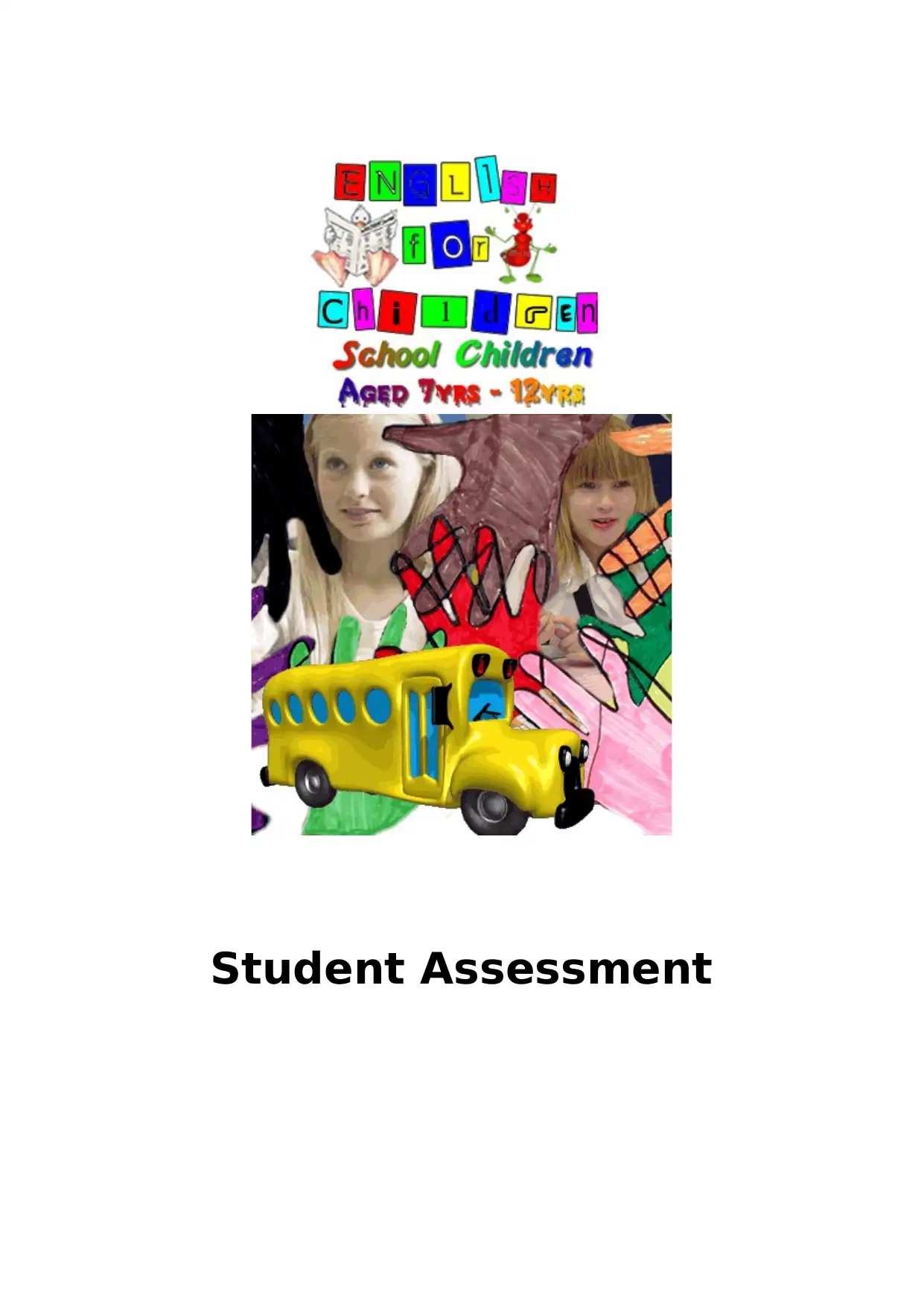
Student Assessment
Paraphrase This Document
Need a fresh take? Get an instant paraphrase of this document with our AI Paraphraser

©2006 ATA TESOL College English for Children Ass.
V03/0115/MA
2
V03/0115/MA
2
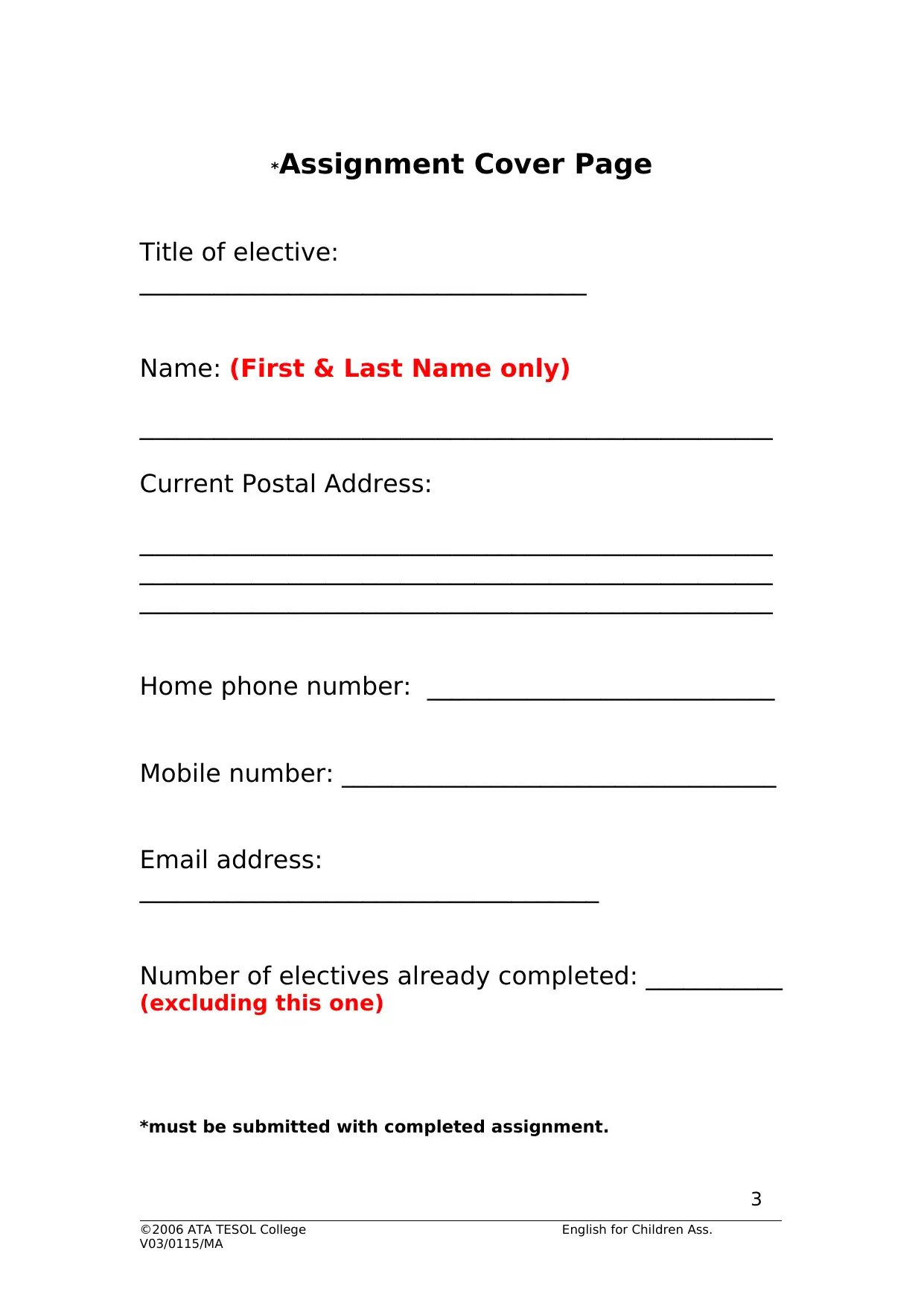
*Assignment Cover Page
Title of elective:
____________________________________
Name: (First & Last Name only)
___________________________________________________
Current Postal Address:
___________________________________________________
___________________________________________________
___________________________________________________
Home phone number: ____________________________
Mobile number: ___________________________________
Email address:
_____________________________________
Number of electives already completed: ___________
(excluding this one)
*must be submitted with completed assignment.
©2006 ATA TESOL College English for Children Ass.
V03/0115/MA
3
Title of elective:
____________________________________
Name: (First & Last Name only)
___________________________________________________
Current Postal Address:
___________________________________________________
___________________________________________________
___________________________________________________
Home phone number: ____________________________
Mobile number: ___________________________________
Email address:
_____________________________________
Number of electives already completed: ___________
(excluding this one)
*must be submitted with completed assignment.
©2006 ATA TESOL College English for Children Ass.
V03/0115/MA
3
⊘ This is a preview!⊘
Do you want full access?
Subscribe today to unlock all pages.

Trusted by 1+ million students worldwide
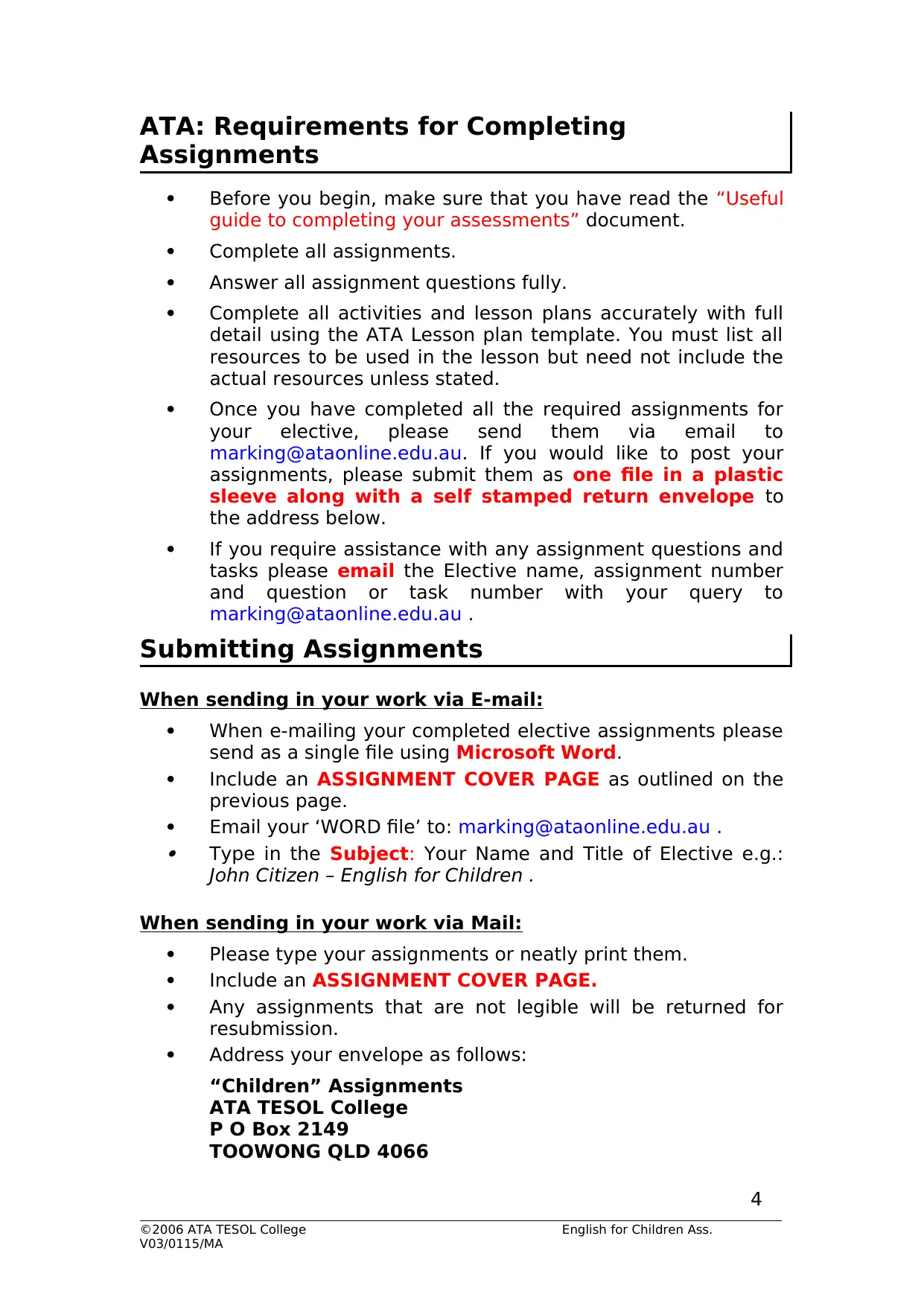
ATA: Requirements for Completing
Assignments
Before you begin, make sure that you have read the “Useful
guide to completing your assessments” document.
Complete all assignments.
Answer all assignment questions fully.
Complete all activities and lesson plans accurately with full
detail using the ATA Lesson plan template. You must list all
resources to be used in the lesson but need not include the
actual resources unless stated.
Once you have completed all the required assignments for
your elective, please send them via email to
marking@ataonline.edu.au. If you would like to post your
assignments, please submit them as one file in a plastic
sleeve along with a self stamped return envelope to
the address below.
If you require assistance with any assignment questions and
tasks please email the Elective name, assignment number
and question or task number with your query to
marking@ataonline.edu.au .
Submitting Assignments
When sending in your work via E-mail:
When e-mailing your completed elective assignments please
send as a single file using Microsoft Word.
Include an ASSIGNMENT COVER PAGE as outlined on the
previous page.
Email your ‘WORD file’ to: marking@ataonline.edu.au .
Type in the Subject: Your Name and Title of Elective e.g.:
John Citizen – English for Children .
When sending in your work via Mail:
Please type your assignments or neatly print them.
Include an ASSIGNMENT COVER PAGE.
Any assignments that are not legible will be returned for
resubmission.
Address your envelope as follows:
“Children” Assignments
ATA TESOL College
P O Box 2149
TOOWONG QLD 4066
©2006 ATA TESOL College English for Children Ass.
V03/0115/MA
4
Assignments
Before you begin, make sure that you have read the “Useful
guide to completing your assessments” document.
Complete all assignments.
Answer all assignment questions fully.
Complete all activities and lesson plans accurately with full
detail using the ATA Lesson plan template. You must list all
resources to be used in the lesson but need not include the
actual resources unless stated.
Once you have completed all the required assignments for
your elective, please send them via email to
marking@ataonline.edu.au. If you would like to post your
assignments, please submit them as one file in a plastic
sleeve along with a self stamped return envelope to
the address below.
If you require assistance with any assignment questions and
tasks please email the Elective name, assignment number
and question or task number with your query to
marking@ataonline.edu.au .
Submitting Assignments
When sending in your work via E-mail:
When e-mailing your completed elective assignments please
send as a single file using Microsoft Word.
Include an ASSIGNMENT COVER PAGE as outlined on the
previous page.
Email your ‘WORD file’ to: marking@ataonline.edu.au .
Type in the Subject: Your Name and Title of Elective e.g.:
John Citizen – English for Children .
When sending in your work via Mail:
Please type your assignments or neatly print them.
Include an ASSIGNMENT COVER PAGE.
Any assignments that are not legible will be returned for
resubmission.
Address your envelope as follows:
“Children” Assignments
ATA TESOL College
P O Box 2149
TOOWONG QLD 4066
©2006 ATA TESOL College English for Children Ass.
V03/0115/MA
4
Paraphrase This Document
Need a fresh take? Get an instant paraphrase of this document with our AI Paraphraser
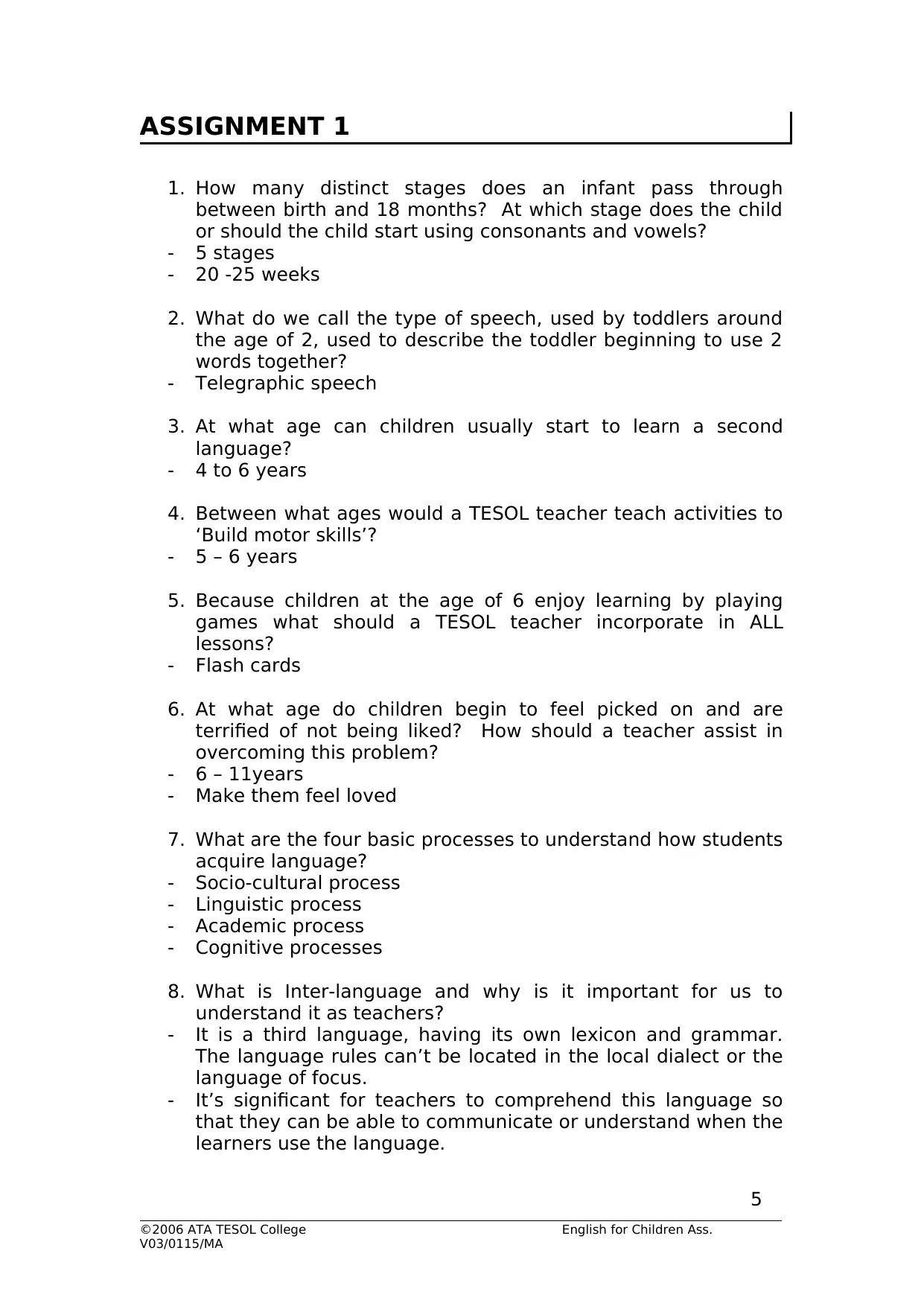
ASSIGNMENT 1
1. How many distinct stages does an infant pass through
between birth and 18 months? At which stage does the child
or should the child start using consonants and vowels?
- 5 stages
- 20 -25 weeks
2. What do we call the type of speech, used by toddlers around
the age of 2, used to describe the toddler beginning to use 2
words together?
- Telegraphic speech
3. At what age can children usually start to learn a second
language?
- 4 to 6 years
4. Between what ages would a TESOL teacher teach activities to
‘Build motor skills’?
- 5 – 6 years
5. Because children at the age of 6 enjoy learning by playing
games what should a TESOL teacher incorporate in ALL
lessons?
- Flash cards
6. At what age do children begin to feel picked on and are
terrified of not being liked? How should a teacher assist in
overcoming this problem?
- 6 – 11years
- Make them feel loved
7. What are the four basic processes to understand how students
acquire language?
- Socio-cultural process
- Linguistic process
- Academic process
- Cognitive processes
8. What is Inter-language and why is it important for us to
understand it as teachers?
- It is a third language, having its own lexicon and grammar.
The language rules can’t be located in the local dialect or the
language of focus.
- It’s significant for teachers to comprehend this language so
that they can be able to communicate or understand when the
learners use the language.
©2006 ATA TESOL College English for Children Ass.
V03/0115/MA
5
1. How many distinct stages does an infant pass through
between birth and 18 months? At which stage does the child
or should the child start using consonants and vowels?
- 5 stages
- 20 -25 weeks
2. What do we call the type of speech, used by toddlers around
the age of 2, used to describe the toddler beginning to use 2
words together?
- Telegraphic speech
3. At what age can children usually start to learn a second
language?
- 4 to 6 years
4. Between what ages would a TESOL teacher teach activities to
‘Build motor skills’?
- 5 – 6 years
5. Because children at the age of 6 enjoy learning by playing
games what should a TESOL teacher incorporate in ALL
lessons?
- Flash cards
6. At what age do children begin to feel picked on and are
terrified of not being liked? How should a teacher assist in
overcoming this problem?
- 6 – 11years
- Make them feel loved
7. What are the four basic processes to understand how students
acquire language?
- Socio-cultural process
- Linguistic process
- Academic process
- Cognitive processes
8. What is Inter-language and why is it important for us to
understand it as teachers?
- It is a third language, having its own lexicon and grammar.
The language rules can’t be located in the local dialect or the
language of focus.
- It’s significant for teachers to comprehend this language so
that they can be able to communicate or understand when the
learners use the language.
©2006 ATA TESOL College English for Children Ass.
V03/0115/MA
5

9. What is language distance? And which language is more
distant from English: Korean or Spanish? Why?
- This is how one language is different from another.
- Korean is distant because of the variance in the structure of
the sentence and word
10. In lesson planning for children why is it extremely
important to be well prepared and have back-up activities
already planned?
- To keep you on track and keeps the kids on track
- Let’s you track progress and problems
©2006 ATA TESOL College English for Children Ass.
V03/0115/MA
6
distant from English: Korean or Spanish? Why?
- This is how one language is different from another.
- Korean is distant because of the variance in the structure of
the sentence and word
10. In lesson planning for children why is it extremely
important to be well prepared and have back-up activities
already planned?
- To keep you on track and keeps the kids on track
- Let’s you track progress and problems
©2006 ATA TESOL College English for Children Ass.
V03/0115/MA
6
⊘ This is a preview!⊘
Do you want full access?
Subscribe today to unlock all pages.

Trusted by 1+ million students worldwide
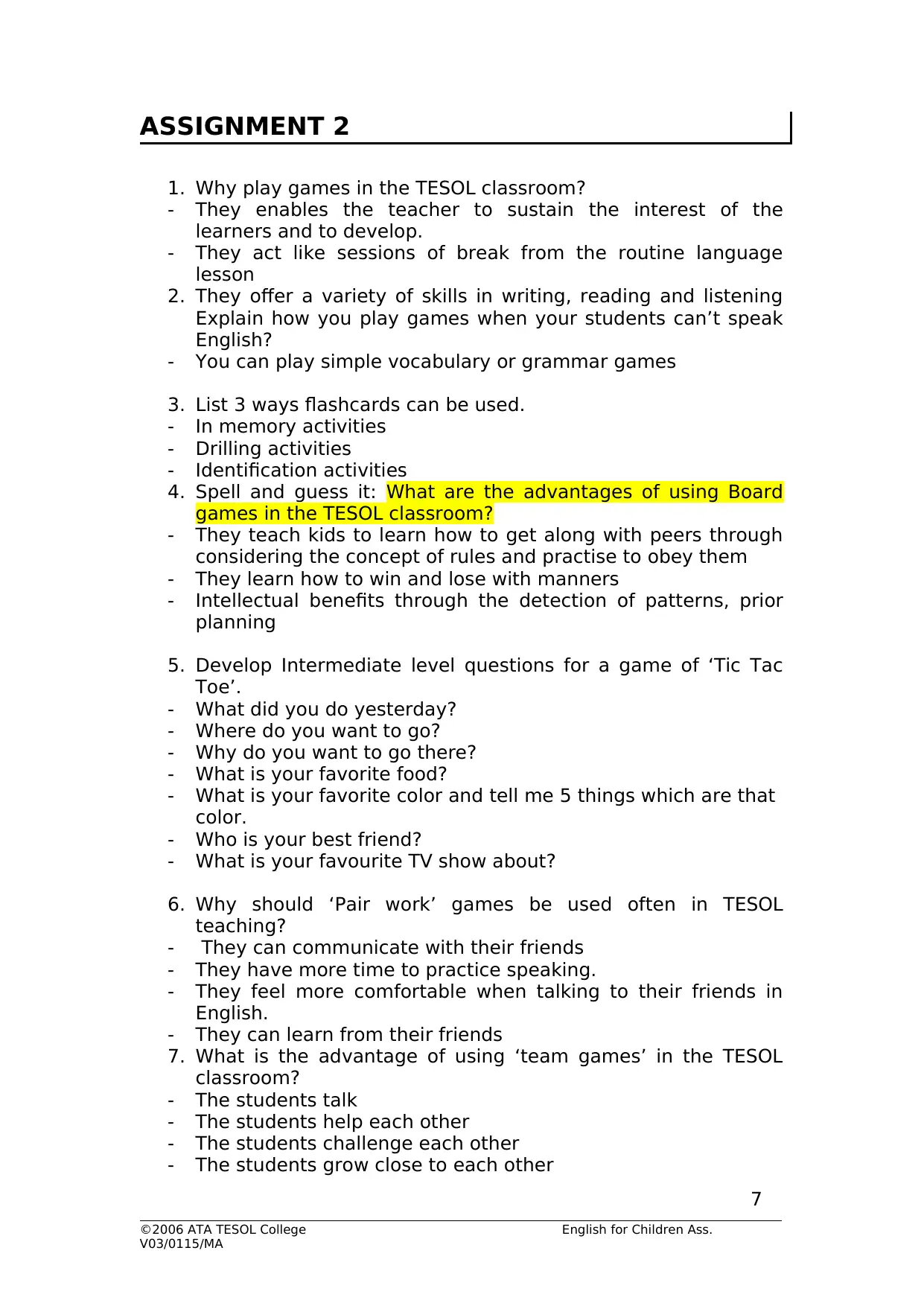
ASSIGNMENT 2
1. Why play games in the TESOL classroom?
- They enables the teacher to sustain the interest of the
learners and to develop.
- They act like sessions of break from the routine language
lesson
2. They offer a variety of skills in writing, reading and listening
Explain how you play games when your students can’t speak
English?
- You can play simple vocabulary or grammar games
3. List 3 ways flashcards can be used.
- In memory activities
- Drilling activities
- Identification activities
4. Spell and guess it: What are the advantages of using Board
games in the TESOL classroom?
- They teach kids to learn how to get along with peers through
considering the concept of rules and practise to obey them
- They learn how to win and lose with manners
- Intellectual benefits through the detection of patterns, prior
planning
5. Develop Intermediate level questions for a game of ‘Tic Tac
Toe’.
- What did you do yesterday?
- Where do you want to go?
- Why do you want to go there?
- What is your favorite food?
- What is your favorite color and tell me 5 things which are that
color.
- Who is your best friend?
- What is your favourite TV show about?
6. Why should ‘Pair work’ games be used often in TESOL
teaching?
- They can communicate with their friends
- They have more time to practice speaking.
- They feel more comfortable when talking to their friends in
English.
- They can learn from their friends
7. What is the advantage of using ‘team games’ in the TESOL
classroom?
- The students talk
- The students help each other
- The students challenge each other
- The students grow close to each other
©2006 ATA TESOL College English for Children Ass.
V03/0115/MA
7
1. Why play games in the TESOL classroom?
- They enables the teacher to sustain the interest of the
learners and to develop.
- They act like sessions of break from the routine language
lesson
2. They offer a variety of skills in writing, reading and listening
Explain how you play games when your students can’t speak
English?
- You can play simple vocabulary or grammar games
3. List 3 ways flashcards can be used.
- In memory activities
- Drilling activities
- Identification activities
4. Spell and guess it: What are the advantages of using Board
games in the TESOL classroom?
- They teach kids to learn how to get along with peers through
considering the concept of rules and practise to obey them
- They learn how to win and lose with manners
- Intellectual benefits through the detection of patterns, prior
planning
5. Develop Intermediate level questions for a game of ‘Tic Tac
Toe’.
- What did you do yesterday?
- Where do you want to go?
- Why do you want to go there?
- What is your favorite food?
- What is your favorite color and tell me 5 things which are that
color.
- Who is your best friend?
- What is your favourite TV show about?
6. Why should ‘Pair work’ games be used often in TESOL
teaching?
- They can communicate with their friends
- They have more time to practice speaking.
- They feel more comfortable when talking to their friends in
English.
- They can learn from their friends
7. What is the advantage of using ‘team games’ in the TESOL
classroom?
- The students talk
- The students help each other
- The students challenge each other
- The students grow close to each other
©2006 ATA TESOL College English for Children Ass.
V03/0115/MA
7
Paraphrase This Document
Need a fresh take? Get an instant paraphrase of this document with our AI Paraphraser
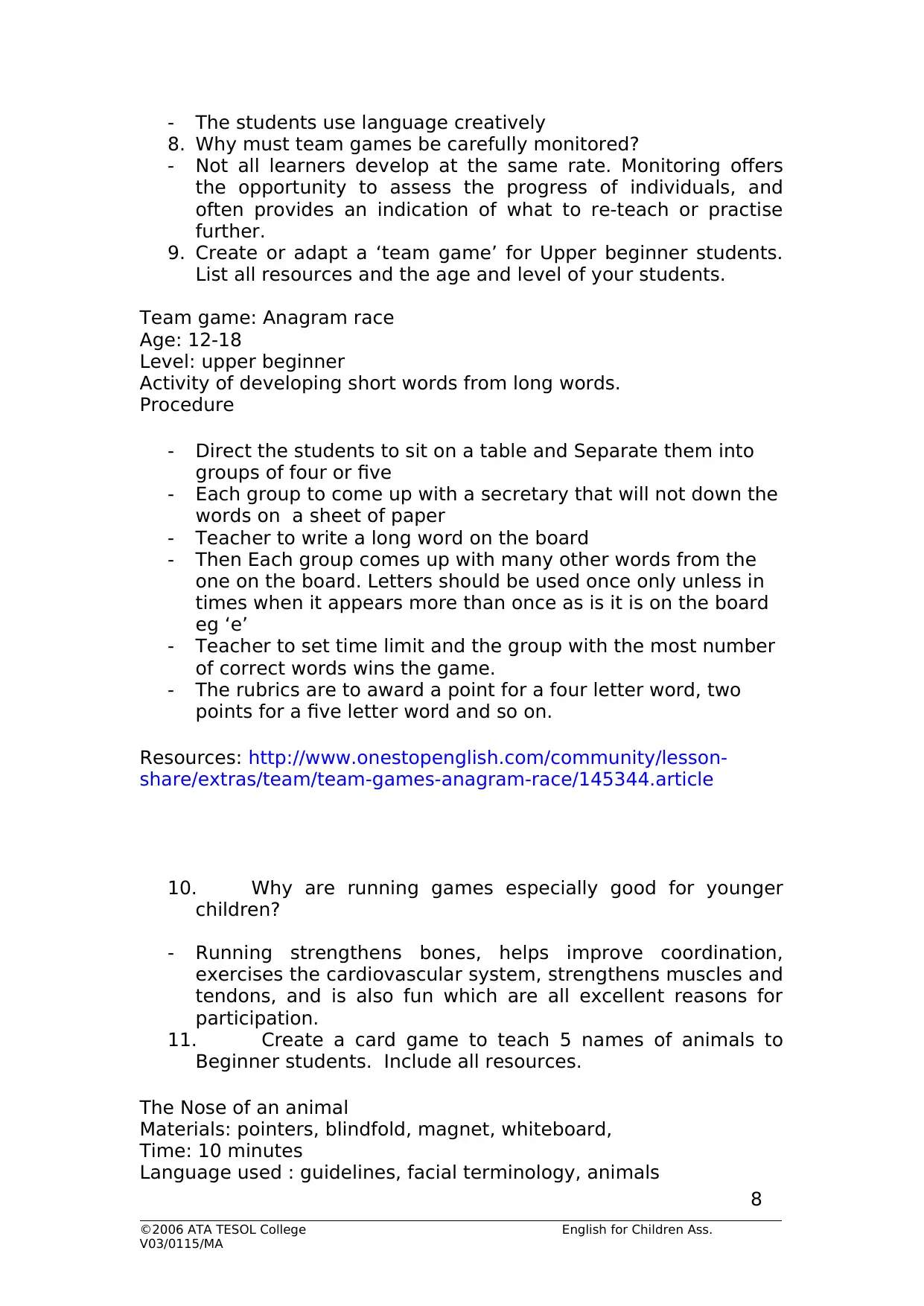
- The students use language creatively
8. Why must team games be carefully monitored?
- Not all learners develop at the same rate. Monitoring offers
the opportunity to assess the progress of individuals, and
often provides an indication of what to re-teach or practise
further.
9. Create or adapt a ‘team game’ for Upper beginner students.
List all resources and the age and level of your students.
Team game: Anagram race
Age: 12-18
Level: upper beginner
Activity of developing short words from long words.
Procedure
- Direct the students to sit on a table and Separate them into
groups of four or five
- Each group to come up with a secretary that will not down the
words on a sheet of paper
- Teacher to write a long word on the board
- Then Each group comes up with many other words from the
one on the board. Letters should be used once only unless in
times when it appears more than once as is it is on the board
eg ‘e’
- Teacher to set time limit and the group with the most number
of correct words wins the game.
- The rubrics are to award a point for a four letter word, two
points for a five letter word and so on.
Resources: http://www.onestopenglish.com/community/lesson-
share/extras/team/team-games-anagram-race/145344.article
10. Why are running games especially good for younger
children?
- Running strengthens bones, helps improve coordination,
exercises the cardiovascular system, strengthens muscles and
tendons, and is also fun which are all excellent reasons for
participation.
11. Create a card game to teach 5 names of animals to
Beginner students. Include all resources.
The Nose of an animal
Materials: pointers, blindfold, magnet, whiteboard,
Time: 10 minutes
Language used : guidelines, facial terminology, animals
©2006 ATA TESOL College English for Children Ass.
V03/0115/MA
8
8. Why must team games be carefully monitored?
- Not all learners develop at the same rate. Monitoring offers
the opportunity to assess the progress of individuals, and
often provides an indication of what to re-teach or practise
further.
9. Create or adapt a ‘team game’ for Upper beginner students.
List all resources and the age and level of your students.
Team game: Anagram race
Age: 12-18
Level: upper beginner
Activity of developing short words from long words.
Procedure
- Direct the students to sit on a table and Separate them into
groups of four or five
- Each group to come up with a secretary that will not down the
words on a sheet of paper
- Teacher to write a long word on the board
- Then Each group comes up with many other words from the
one on the board. Letters should be used once only unless in
times when it appears more than once as is it is on the board
eg ‘e’
- Teacher to set time limit and the group with the most number
of correct words wins the game.
- The rubrics are to award a point for a four letter word, two
points for a five letter word and so on.
Resources: http://www.onestopenglish.com/community/lesson-
share/extras/team/team-games-anagram-race/145344.article
10. Why are running games especially good for younger
children?
- Running strengthens bones, helps improve coordination,
exercises the cardiovascular system, strengthens muscles and
tendons, and is also fun which are all excellent reasons for
participation.
11. Create a card game to teach 5 names of animals to
Beginner students. Include all resources.
The Nose of an animal
Materials: pointers, blindfold, magnet, whiteboard,
Time: 10 minutes
Language used : guidelines, facial terminology, animals
©2006 ATA TESOL College English for Children Ass.
V03/0115/MA
8

Productive Language: facial vocabulary, animals (or family, etc),
directions
details:
- sketch a nose less animal the whiteboard but with eyes, ears,
among other organ
- Demonstrate to the students that the animal is saddened by
the absence of its nose.
- One student is then Blindfolded and provided with the animal
nose (magnet)
- One other student offers direction by shouting whether left,
right or up to the blindfolded student to locate the proper
direction of nose location
- The blindfolded students can also sketch the nose and other
missing facial organs
- The best team is that which will have drawn the best animal.
Resources: http://www.themagiccrayons.com/games/animals/
12 . Create a full 45 minute lesson plan, using the ATA Lesson
Plan Template, for Beginner students. Include 2 different
game tasks and all resources.
Theme: identification of images
Level and age: beginners
Length: 45 minutes
Required language skills: reading and speaking
Language goals: children to identify pictures and communicate
Effectively.
Required methodology: observation of pictures
Needed resources: flash cards, vocabulary and pictures
1. Pre-task: display the pictures to the children
2. Teaching task one: ask the children if they have seen the
images on the flash cards before
3. Task one: children to respond if they have ever come across the
pictures
4. Teaching task two: instruct the children to mention the names
of the pictures
5. Task two: children to mention the name so the pictures on the
flashcards
6. Teaching task three: the children to be shown bigger pictures
©2006 ATA TESOL College English for Children Ass.
V03/0115/MA
9
directions
details:
- sketch a nose less animal the whiteboard but with eyes, ears,
among other organ
- Demonstrate to the students that the animal is saddened by
the absence of its nose.
- One student is then Blindfolded and provided with the animal
nose (magnet)
- One other student offers direction by shouting whether left,
right or up to the blindfolded student to locate the proper
direction of nose location
- The blindfolded students can also sketch the nose and other
missing facial organs
- The best team is that which will have drawn the best animal.
Resources: http://www.themagiccrayons.com/games/animals/
12 . Create a full 45 minute lesson plan, using the ATA Lesson
Plan Template, for Beginner students. Include 2 different
game tasks and all resources.
Theme: identification of images
Level and age: beginners
Length: 45 minutes
Required language skills: reading and speaking
Language goals: children to identify pictures and communicate
Effectively.
Required methodology: observation of pictures
Needed resources: flash cards, vocabulary and pictures
1. Pre-task: display the pictures to the children
2. Teaching task one: ask the children if they have seen the
images on the flash cards before
3. Task one: children to respond if they have ever come across the
pictures
4. Teaching task two: instruct the children to mention the names
of the pictures
5. Task two: children to mention the name so the pictures on the
flashcards
6. Teaching task three: the children to be shown bigger pictures
©2006 ATA TESOL College English for Children Ass.
V03/0115/MA
9
⊘ This is a preview!⊘
Do you want full access?
Subscribe today to unlock all pages.

Trusted by 1+ million students worldwide
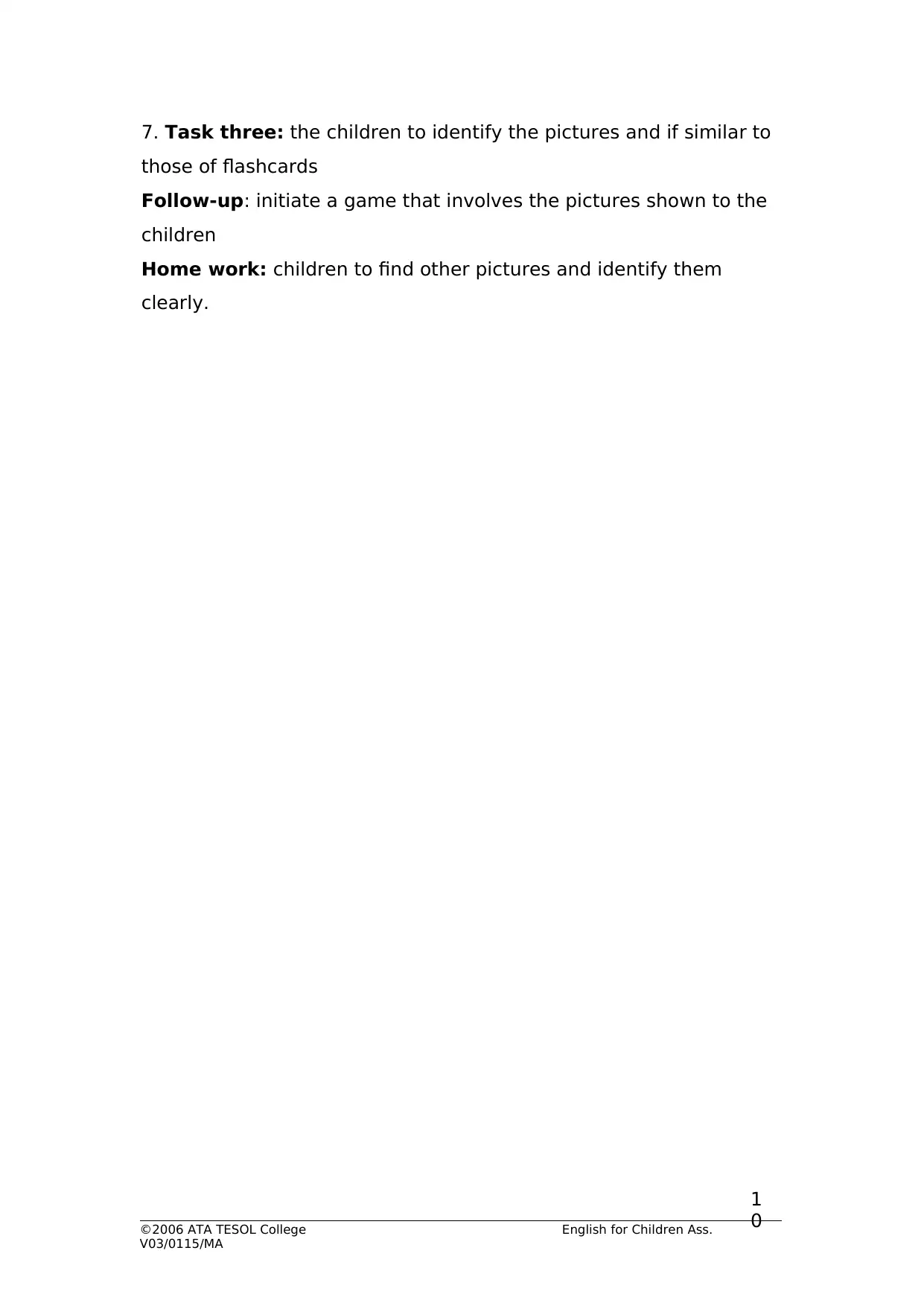
7. Task three: the children to identify the pictures and if similar to
those of flashcards
Follow-up: initiate a game that involves the pictures shown to the
children
Home work: children to find other pictures and identify them
clearly.
©2006 ATA TESOL College English for Children Ass.
V03/0115/MA
1
0
those of flashcards
Follow-up: initiate a game that involves the pictures shown to the
children
Home work: children to find other pictures and identify them
clearly.
©2006 ATA TESOL College English for Children Ass.
V03/0115/MA
1
0
Paraphrase This Document
Need a fresh take? Get an instant paraphrase of this document with our AI Paraphraser
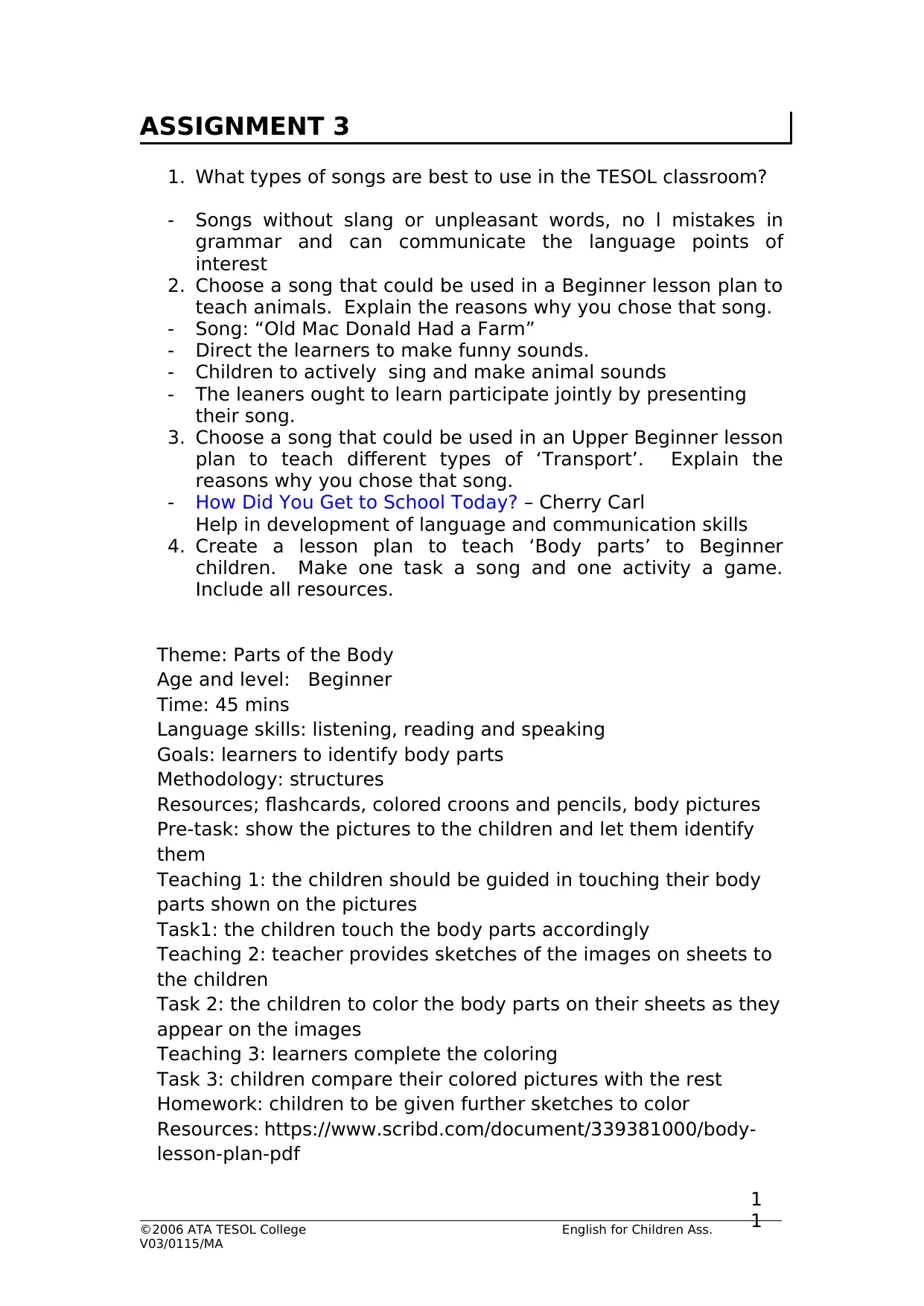
ASSIGNMENT 3
1. What types of songs are best to use in the TESOL classroom?
- Songs without slang or unpleasant words, no l mistakes in
grammar and can communicate the language points of
interest
2. Choose a song that could be used in a Beginner lesson plan to
teach animals. Explain the reasons why you chose that song.
- Song: “Old Mac Donald Had a Farm”
- Direct the learners to make funny sounds.
- Children to actively sing and make animal sounds
- The leaners ought to learn participate jointly by presenting
their song.
3. Choose a song that could be used in an Upper Beginner lesson
plan to teach different types of ‘Transport’. Explain the
reasons why you chose that song.
- How Did You Get to School Today? – Cherry Carl
Help in development of language and communication skills
4. Create a lesson plan to teach ‘Body parts’ to Beginner
children. Make one task a song and one activity a game.
Include all resources.
Theme: Parts of the Body
Age and level: Beginner
Time: 45 mins
Language skills: listening, reading and speaking
Goals: learners to identify body parts
Methodology: structures
Resources; flashcards, colored croons and pencils, body pictures
Pre-task: show the pictures to the children and let them identify
them
Teaching 1: the children should be guided in touching their body
parts shown on the pictures
Task1: the children touch the body parts accordingly
Teaching 2: teacher provides sketches of the images on sheets to
the children
Task 2: the children to color the body parts on their sheets as they
appear on the images
Teaching 3: learners complete the coloring
Task 3: children compare their colored pictures with the rest
Homework: children to be given further sketches to color
Resources: https://www.scribd.com/document/339381000/body-
lesson-plan-pdf
©2006 ATA TESOL College English for Children Ass.
V03/0115/MA
1
1
1. What types of songs are best to use in the TESOL classroom?
- Songs without slang or unpleasant words, no l mistakes in
grammar and can communicate the language points of
interest
2. Choose a song that could be used in a Beginner lesson plan to
teach animals. Explain the reasons why you chose that song.
- Song: “Old Mac Donald Had a Farm”
- Direct the learners to make funny sounds.
- Children to actively sing and make animal sounds
- The leaners ought to learn participate jointly by presenting
their song.
3. Choose a song that could be used in an Upper Beginner lesson
plan to teach different types of ‘Transport’. Explain the
reasons why you chose that song.
- How Did You Get to School Today? – Cherry Carl
Help in development of language and communication skills
4. Create a lesson plan to teach ‘Body parts’ to Beginner
children. Make one task a song and one activity a game.
Include all resources.
Theme: Parts of the Body
Age and level: Beginner
Time: 45 mins
Language skills: listening, reading and speaking
Goals: learners to identify body parts
Methodology: structures
Resources; flashcards, colored croons and pencils, body pictures
Pre-task: show the pictures to the children and let them identify
them
Teaching 1: the children should be guided in touching their body
parts shown on the pictures
Task1: the children touch the body parts accordingly
Teaching 2: teacher provides sketches of the images on sheets to
the children
Task 2: the children to color the body parts on their sheets as they
appear on the images
Teaching 3: learners complete the coloring
Task 3: children compare their colored pictures with the rest
Homework: children to be given further sketches to color
Resources: https://www.scribd.com/document/339381000/body-
lesson-plan-pdf
©2006 ATA TESOL College English for Children Ass.
V03/0115/MA
1
1
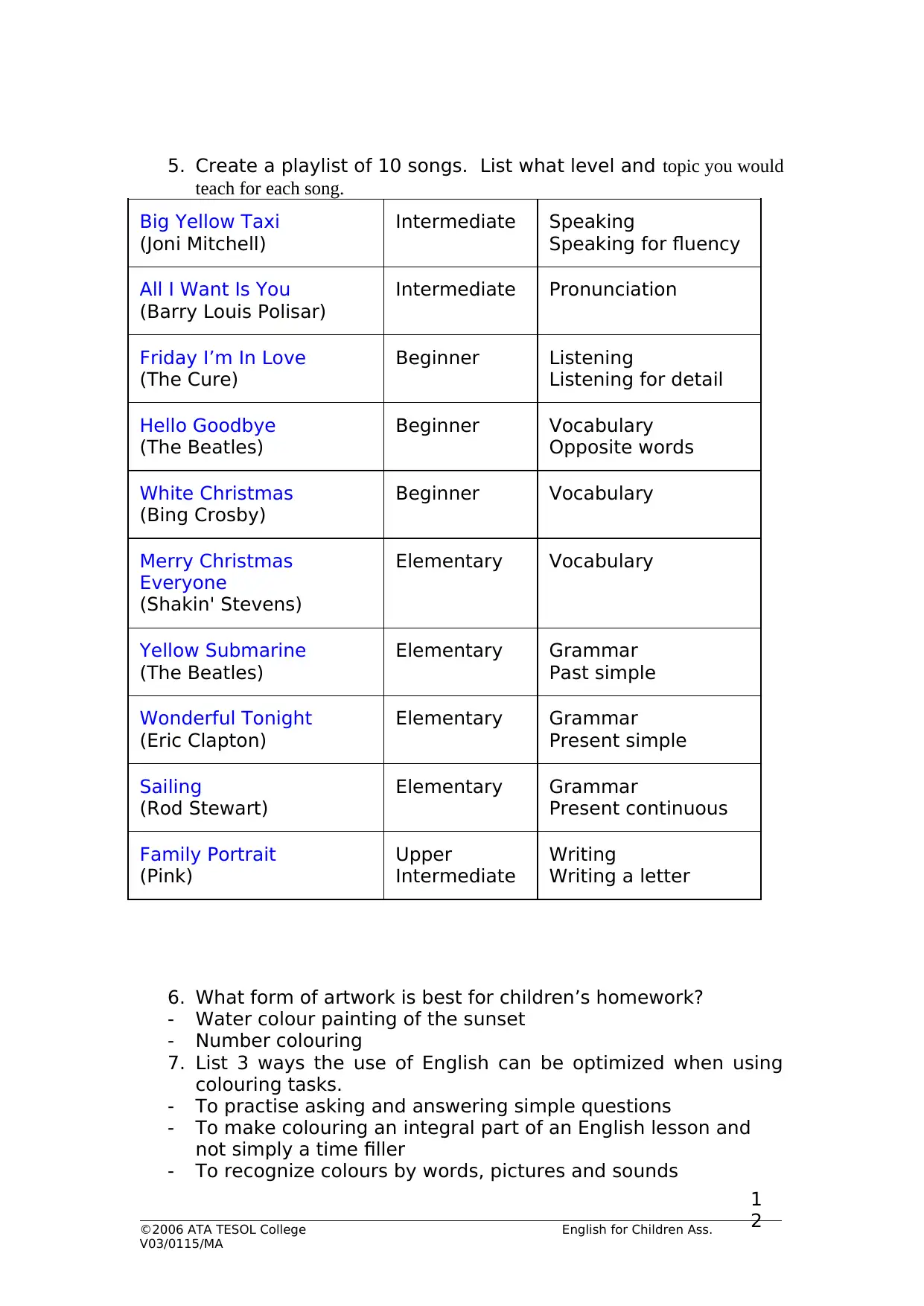
5. Create a playlist of 10 songs. List what level and topic you would
teach for each song.
Big Yellow Taxi
(Joni Mitchell)
Intermediate Speaking
Speaking for fluency
All I Want Is You
(Barry Louis Polisar)
Intermediate Pronunciation
Friday I’m In Love
(The Cure)
Beginner Listening
Listening for detail
Hello Goodbye
(The Beatles)
Beginner Vocabulary
Opposite words
White Christmas
(Bing Crosby)
Beginner Vocabulary
Merry Christmas
Everyone
(Shakin' Stevens)
Elementary Vocabulary
Yellow Submarine
(The Beatles)
Elementary Grammar
Past simple
Wonderful Tonight
(Eric Clapton)
Elementary Grammar
Present simple
Sailing
(Rod Stewart)
Elementary Grammar
Present continuous
Family Portrait
(Pink)
Upper
Intermediate
Writing
Writing a letter
6. What form of artwork is best for children’s homework?
- Water colour painting of the sunset
- Number colouring
7. List 3 ways the use of English can be optimized when using
colouring tasks.
- To practise asking and answering simple questions
- To make colouring an integral part of an English lesson and
not simply a time filler
- To recognize colours by words, pictures and sounds
©2006 ATA TESOL College English for Children Ass.
V03/0115/MA
1
2
teach for each song.
Big Yellow Taxi
(Joni Mitchell)
Intermediate Speaking
Speaking for fluency
All I Want Is You
(Barry Louis Polisar)
Intermediate Pronunciation
Friday I’m In Love
(The Cure)
Beginner Listening
Listening for detail
Hello Goodbye
(The Beatles)
Beginner Vocabulary
Opposite words
White Christmas
(Bing Crosby)
Beginner Vocabulary
Merry Christmas
Everyone
(Shakin' Stevens)
Elementary Vocabulary
Yellow Submarine
(The Beatles)
Elementary Grammar
Past simple
Wonderful Tonight
(Eric Clapton)
Elementary Grammar
Present simple
Sailing
(Rod Stewart)
Elementary Grammar
Present continuous
Family Portrait
(Pink)
Upper
Intermediate
Writing
Writing a letter
6. What form of artwork is best for children’s homework?
- Water colour painting of the sunset
- Number colouring
7. List 3 ways the use of English can be optimized when using
colouring tasks.
- To practise asking and answering simple questions
- To make colouring an integral part of an English lesson and
not simply a time filler
- To recognize colours by words, pictures and sounds
©2006 ATA TESOL College English for Children Ass.
V03/0115/MA
1
2
⊘ This is a preview!⊘
Do you want full access?
Subscribe today to unlock all pages.

Trusted by 1+ million students worldwide
1 out of 18
Related Documents
Your All-in-One AI-Powered Toolkit for Academic Success.
+13062052269
info@desklib.com
Available 24*7 on WhatsApp / Email
![[object Object]](/_next/static/media/star-bottom.7253800d.svg)
Unlock your academic potential
Copyright © 2020–2025 A2Z Services. All Rights Reserved. Developed and managed by ZUCOL.





